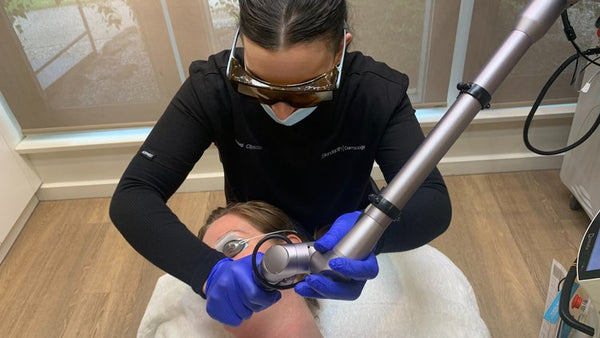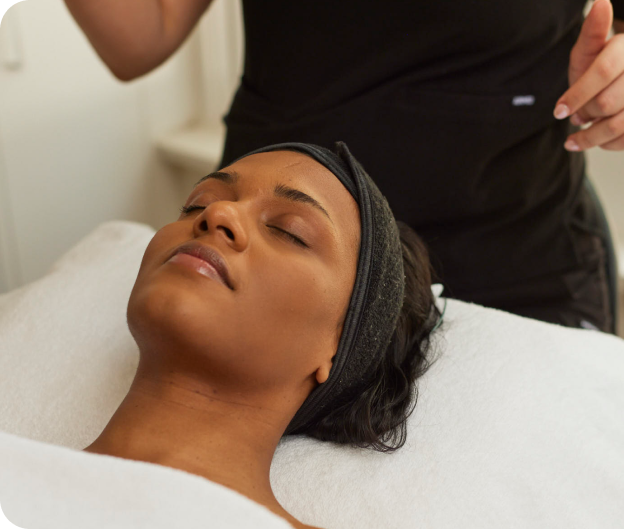
Pigmentation is one of the most common concerns we treat at Skindepth, and it certainly manifests in different ways and is triggered by different things. Due to there being so many different types of pigmentation to the skin, it’s important to first work out which one is occurring to effectively treat it. Lets jump into some of the forms and causes of hyper and hypo-pigmentation, below.
What are the different types of pigmentation and what are the differences?
Epidermal Pigmentation: This is pigmentation that is found on the superficial layer of the skin and is typically caused by sun exposure. Examples are:
Freckles: The most common type of pigmentation. Freckles also known as ‘ephelides’ are caused by sun exposure and are hereditary. They can lighten in the cooler months and are usually seen in fairer skins types.
Solar Lentigines: Similar to freckles, solar lentigos are benign, larger, sun induced brown spots that are well circumscribed and flat in appearance.
Dermal Pigmentation: The deepest form of pigmentation located in the dermis. Examples include; Hori’s Macule and Nevus of Ota. These types of pigmentation often have a grey- blue and black-brown appearance and are caused by hormones as well as genetics.
Mixed Epidermal and Dermal Pigmentation, typically seen in Melasma: A chronic skin condition that is characterised by darkened patches on the face, typically the cheeks, forehead and upper lip. It’s exacerbated during hormonal changes in the body such as pregnancy or medications such as the contraceptive pill, and is often found in women. It can also be further stimulated by heat and UV exposure.
Post Inflammatory Hyper / Hypo pigmentation: As a result of injury to the skin such as burns and acne lesions and general scarring. Hyper pigmentation is excess pigment gained after skin injury, and will resolve over time with topical intervention. Hypo pigmentation means there is an absence of pigmentation and can be permanent in some cases.

This is an example of Post Inflammatory HyperPigmentation, caused by trauma to the skin from acne scarring.
Can pigment be removed?
Pigmentation can absolutely be removed! However, Melasma is a chronic condition that never completely resolves, we can simply manage triggers that will improve the appearance.

This is our Pastelle QSwitch Laser in action, perfect for shattering pigmented lesions within the epidermal or dermal layer of the skin.
My skin is discoloured, what do I do?
If your skin is discoloured consider your sun protective measures such as SPF and protective clothing (hat, sunglasses etc). Also, consider topical skincare that can brighten the skin. It is best to consult with a dermal clinician to consider the best products for your skin concerns.
What creams are best for pigment?
The Creams best for pigmentation include;
Dermaceutic Melacream: A cream designed to prevent further pigmentation and lighten existing discolouration. Containg: Kojic Acid, Niacinamide, Retinol, Salicylic Acid, Phytic Acid, Licorice Extract, and Mandelic Acid. Perfect for someone looking for an active that delivers for both pigment and ageing concerns.
Aspect Complete Pigment Plus: A light-weight serum suitable for sensitive skin types as well as those pregnant and breastfeeding. Containing a blend of ingredients that regulate and inhibit pigmentation. Formulated with Tranexamic acid; an amino acid to diminish the appearance of existing dark spots and further prevent future pigmentation. Niacinamide (Vit B3) balance over all skin barrier and appearance. Plus, a signature blend of Australian botanicals.
The pigment treatments we offer at Skindepth Dermatology
Advanced Peels: These are a terrific way to minimise the appearance of superficial pigment. Chemical exfoliating acids such as mandelic, citric and glycolic can all help to reduce superficial pigmentation by removing the top ‘dead’ layer of skin cells that accumulate on the skins surface and increase the appearance of pigment. One of our most affective advanced peels is a TCA peel (full name; Trichloroacetic acid!) They are ideal for hyperpigmentation caused by sun exposure and environmental aggressors.
Our TCA peels vary in strength which means there may be some recovery time required; this can be customised to your needs and will be discussed with your clinician prior to your treatment. The strength of the TCA peel used determines how deep the peel will penetrate into the skin; the higher the percentage, the deeper it will go! This is fantastic as it will target the pigment within multiple layers of the epidermis. TCA is also very effective at improving the health and quality of sun-damaged skin- improving wrinkles, sallow skin, and dullness.
Price: $250
Treatment time: 45 minutes
Inclusions: Double cleanse, exfoliation, peel prep, appropriate acid peel, LED light therapy, serums & SPF moisturiser to finish!Just as mentioned above, combining the powers of cosmetic injectables with other types of treatments can be one of the most prolific ways to create positive change within the skin, that isn’t surgical.
Pigment Laser: Our Pigment Laser uses ‘photoacoustic energy’ to target pigmented lesions within the epidermal or dermal layer of the skin. As the pigment absorbs the light, the laser heats up and shatters the pigment, drawing it to the surface without damaging the surrounding tissue.
The natural immune response to this treatment removes these cells from the body within a 4-6 week period. Depending on the depth and size of the area that we are treating, 3 initial sessions are usually required to achieve desired results, however you may notice lightening or size reduction of the pigmentation after even the first treatment! This treatment is ideal for all types of pigment, whether it be superficial (sitting in the upper layers of the skin) or deeper in the dermis.
Price: $90 - $505 per session (area size dependant)
Treatment time: 15 – 45 minutes (area size dependant)
Inclusions: Cleanse, prep area, pigment laser, after care products applied.
Downtime: This will vary depending on the type of pigment being treated. You may experience some of the following:
3 –5 days: Swelling/redness
3 – 7 days: Micro-crusting/slight scabbing. This may be longer on certain body areas.
5 – 7 days: Bruising
7 – 14 days: Temporary darkening of the area
 Here is Dr Alice Rudd showing us which products are included within our very special March ‘Brighten Package’ which aims to inflict dramatic change to those concerned with pigment, at a reduced price!
Here is Dr Alice Rudd showing us which products are included within our very special March ‘Brighten Package’ which aims to inflict dramatic change to those concerned with pigment, at a reduced price!
The very special March ‘Brighten Package’ is a multi-phase treatment option to optimise results by utilising these different modalities!
The Brighten Package Includes:
1 x Superficial Peel & LED
2 x Advanced Peels
3 x Pigment Laser: Medium size sessions
1 x Full size Mela Cream
1 x Kceutic SPF (SPF may be swapped for a different type if Kceutic is not suitable)
Price: $1800 (valued at $2178)
Timeline: 4 – 6 months
Available to start this month!
To check your eligibility for this package, book in a skin consult with one of our clinicians, reach us at (03) 9100 3183, text on +61 482 091 750, cosmetic@skindepth.com.au, or send through a DM on Instagram.
